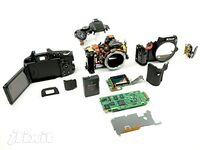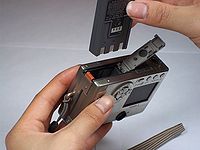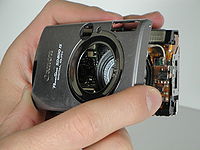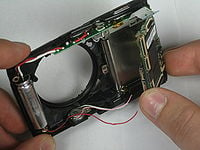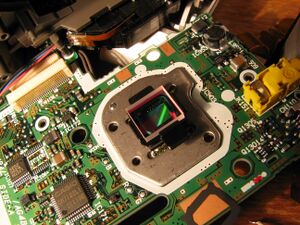
This is a speculative class project and needs to be refined before being deployed at any scale.
In recent years the application of digital imaging devices has seen an exponential growth in the technological, industrial, and entertainment sectors, while continuing to pervade other fields once thought impossible. Since the late 1960s, this boom has been spurred by advancements in the two main image sensor technologies, CCDW (charge-coupled device) and CMOSW (complementary metal oxide semiconductor).[1] Both imaging technologies utilize a rectangular array of millions of photosites, which capture photons and convert the charge of the electrons produced via the photoelectric effect in a silicon photodiode substrate into an analog signal.[2] The method of converting this signal to digital and the subsequent read out is what differs between these two types of sensors. Each photodiode of a CMOS image sensor contains its own analog to digital converter and is connected via wires to the readout, thus allowing the information from each pixel to be access individually.[3] CCD photosites on the other hand, are grouped in linear horizontal arrays which transport the electron packets of each pixel to register readout.[4] Once this process is completed for a given row, its electron information is wiped clear and the next row shifts to take its place.[4]These differences affect the fundamental properties and performance of the image sensors that employ either technology.
The current digital imaging market has been dominated in the past several years by CMOS sensors due to their relative low cost and low power requirement which satisfy the consumer's desire for cheap devices with long battery life.[1]Companies that currently fabricate image sensors include Canon, Nikon, Sony, Sharp, Samsung, Toshiba, Eastman Kodak, Omnivision, and others. During the initial stages of the market's development, many image sensor start-ups went out of business due to the risks in competing for high-volume commodity applications and the subsequent price wars which followed.[1]Today interest is focused primarily on the development of high performance CMOS sensors because of expectations of lowered-power consumption, increased on-chip functionality, and lower fabrication cost due to reuse of established integrated circuit manufacturing facilities.[5] CCD devices still however continue to be produced for certain low noise – high image quality applications.[3]Advances in both technologies have allowed for the creation of imaging systems that challenge preconceived notions of what was thought possible for both technologies, such as low powered CCD sensors for cellphones and CMOS sensors for high quality DSLR cameras.[6] Both Nikon and Cannon are committed to CMOS sensors for their professional line of cameras as are many other digital camera/camcorder manufacturers.[4]Both CCD and CMOS sensor fabrication begins with a silicon wafer that is used as a substrate for the device (often 150mm for CCD and 200mm for CMOS).[7] After doping is complete the silicon photodiodes for both technologies will produce a charge when due to the photoelectric effect. As long as the energy is present to excite electrons into the conduction band a monochromatic signal may be recorded. To achieve color contrast filters are placed onto of the photodiode layer.[2]The most common filter used is known as the Bayer filter array that consists of alternating red-green, blue-green rows.[2]Other filters such as those produced by Foveon, contain photosensitive red, green, blue layers for each photosite, effectively eliminating the need for complex demosaicing image processing and the artifacts that accompanies it in certain situations.[8] In CMOS image sensors, the transistors and wiring is packed on the periphery of the photosite.[7]This results in an overall large area of the sensor which does not contain regions that are able to capture photons.[2]In order to circumvent this loss of intensity, a micro lens is placed on top of the pixel element to focus incident photons onto the photodiode and away from transistors/wiring that would cause undesirable photon scattering and absorption.[7]A protective SiO2 layer is then added on to the surface of the sensor to protect it from debris and allow for cleaning without damaging the delicate components of the sensor.[7]There is a multitude of sensor properties and criteria that designers must be aware off when fabricating a sensor whether it be CCD or CMOS for a particular application. Device manufacturers purchasing these image sensors also must have a good working knowledge of these factors and there interrelation if the most appropriate sensor is to be selected.
Critical Image Sensor Parameters[edit | edit source]
- Fill Factor: Inverse relationship between the number of transistors in a CMOS photosite and the overall sensors fill factor. This directly impacts the sensitivity of the sensor and therefore the signal-to-noise ratio. More transistors allows though for critical features such as global shutter and sampling.[6]
- Light Acceptance Angle: Micro lenses compensate for a decrease in fill factor (higher surface area occupied by transistors in CMOS sensors). Micro lenses reduce the acceptance angle of a given pixel and its ability to capture a large number of photons quickly.[6]
- Pixel Charge Capacity: Higher capacities allow for a higher signal to be captured in order to reduce the signal-to-noise ratio. A higher charge capacity also allows for higher levels of intensity to be recorded without pixel blow out.[6]
- Minimum Exposure Time: Directly affects the maximum speed of an imaging system. A sensor with high exposure time will exhibit artifacts if higher frame rates are desired for a given application.[6]
- Minimum Achievable Noise Level: Very important in low light – photon starved conditions. Complex chip circuitry and defects from within the silicon photodiode will increase the noise floor of a given sensor.[6]
- Dynamic Range: The range over which electron generation within the photodiode is linear with the concentration of impinging photons. This practically determines the intensity range for which a sensor is optimized for. CCD technology traditionally exhibits higher dynamic range than CMOS.[1]
- Uniformity: Analog-to-digital conversion in CMOS sensors takes place within a given photosite. This leads often leads to non-uniform signal generation which must be corrected with subsequent image processing methods off chip. CCD sensors excel in uniformity because the signal is extracted from the sensor per row and by often only one register.[7]
- Shutter Leakage: In CMOS photosites, the charge on the photodiode must be transferred to a storage area for analog-to-digital conversion. No gate is 100% isolation efficient, thus unwanted signal may be collected by the pixel and inadvertently transferred to the isolated storage, creating image defects.[6]
- Pixel Size: The larger pixel size translates to higher photon sensitivity and pixel charge capacity. Therefore the image quality of devices with larger pixels generally produce better quality images.[4]
- Detector Size: Larger detectors allow for similar resolutions of smaller detectors to be achieved while maintaining pixel size at a suitable level. The image sensors of high-end DSLR cameras are roughly the size of a large postage stamp while the image sensors of "point-and-shoot" cameras with comparable megapixels are often smaller than the area of a fingernail.[9]
- Power Consumption: CCD sensor consume up to 100 times the power required to operate CMOS sensors at standard lighting levels. Consumer drive toward devices with longer battery life.[8]
- Cost: Always a critical factor especially when designing for large scale consumer products. Traditionally cost has always been lower for CMOS fabrication because of use of existing IC production equipment. High quality CMOS sensors require additional industrial processes and therefore cost equivalent to existing CCD fabrication.[3]
- Yield: CMOS processes are one of the highest yield semiconductor fabrication method available. The higher the yield, the lower the end cost for mass producing a given sensor.[1]
Image Sensor Market Analysis[edit | edit source]

Image sensors are used in a wide variety of devices from cameras in mobile phones to security cameras, medical imaging and even the automotive industry.[10] Computers, webcams, and quality control equipment all use image sensors to name a few more.[11] This vast array of applications is one of the main driving points for image sensor growth.
In 2012, approximately 2.25 billion CCD and CMOS image sensor units were sold, a value which is expected to increase by nearly 500 million units by 2014.[12] In addition to the large range of applications, advances in CMOS technology is another key reason why the image sensor sector is growing. For example, decreasing the pixel size allows less silicon to be used which in turn reduces the production cost of the sensor.[13] Additional advances in CMOS are bringing light sensitivity and image quality closer to that of CCD while costing less to produce ($6.50-$10 for CMOS compared to $10-$1000 for CCD).[13] With the ever increasing dependence on electronic devices, it is clear that image sensors will play an increasingly important role as higher demand and better technology continue to provide growth for the image sensor market.
Current Recycling Practices[edit | edit source]
Although image sensors are used in a large variety of devices, there exists no recycling process specifically designed for image sensors. This does not mean however, that all image sensors simply get thrown out or discarded. For example, cell phones with image sensors often either get refurbished and then resold or stripped of their precious metals and the plastic components melted down to make new parts.[14] Since image sensors are a part of the cell phone, they too get either reused or recycled with the rest of the cell phone.
In addition to being refurbished in cell phones, many image sensors are used in the recycling business for sorting glasses and plastics.[15][16] The use of image sensors in the recycling industry allows for greater speed and efficiency in detecting undesirable products.[15] Image sensors also increase efficiency in the recycling process by sorting through large amounts of material in a much shorter period of time compared with physical sorting.[15]
Quantity of Image Sensors Units within Market[edit | edit source]
| Year | Number of Still Cameras Shipped Globally |
|---|---|
| 2010 | 121,463,234 |
| 2009 | 105,863,632 |
| 2008 | 119,756,808 |
| 2007 | 100,367,056 |
| 2006 | 78,981,429 |
| 2005 | 64,766,923 |
| 2004 | 59,765,768 |
| Total Units | 650,964,850 |
As the 2.5 billion image sensors globally are utilized in an enormous variety of commercial and consumer devices, the number of image sensors obtainable from the consumer market must be based on a base mark product that will be certain to contain an image sensor which will be of high enough quality to remain useful for image sensing after extraction. Still image cameras are appropriate as a baseline for market viability. The Camera & Imaging Products Association (CIPA) collects data of global shipments of Still image from participating companies,[17][18] who composed roughly 84.7% of the still image digital camera market in 2010.[19] A three year failure rate for digital cameras of 15.6% was extrapolated by SquareTrade during a two year study,[20] which has been assumed the expected product life of the average digital cameras.
Baseline product: Still Image digital cameras. Assumptions:
- CIPA member compose roughly 84.7% of the still image digital camera market in 2010.[17][19]
- Product life digital camera is expected to be three years.[20]
- CIPA statistics of still cameras shipped globally from two product generations (6 years) from 2004 - 2010 represent the digital cameras in circulation currently.
- Each camera has one image sensor unit.
The approximate size of the total market is 650,964,850+((1-0.847)*650,964,850) = 750,562,472 cameras, which can be seen as 750,562,472 potential image sensors.
Collection of Post-Consumer Image Sensors[edit | edit source]
Electronics components that are recycled are often treated as e-waste, where the device is destroyed and separated into scrap precious metals, polymeric compounds, a glass based products.[21] This is less than optimum, as the value of the device comes from the function that it provides. The process of remarketing in used industry to prevent functioning devices from being underutilized, by incorporating components into devices that they were not originally designed to be used in. Some computer manufactures, such as Dell, use this method to move old stock components, or components recovered from computer trade-ins that still function.[22] Dell© has incorporated post-consumer electronics into their remarketing process through their Dell Reconnect program, which takes refurbishes older computer models of various kinds with a cache of stock parts that are extracted from devices donated to them and proceeds to donate the functioning, refurbished units, to charitable organizations, which in the U.S. is Goodwill.[23][22] The Electronics TakeBack Coalition assess that Dell's 2009 material takebacks from this method were 97 million lbs (roughly 44,000 MT) from its largely U.S. centered 'Americas' region.[22]
There are several commonly used methods to obtain electronic devices for recycling. These devices may be collected either by donation or by compensating the previous owner for his/her device. The later technique is often better for collecting expensive components or components in operational condition rather than those commonly recycled by voluntary means. The physical act of collecting devices often dictates the majority of cost associated with collection and overall efficiency. Many recycling agencies partner with retail outlets in order to provide recycling receptacle in easy to access locations. Others choose to forgo a physical presence in favor for online collection methods. The primary difficulty in this approach is the need for large advertising campaigns in order to collect a substantial amount of devices. Existing collection centers also provide access to recycled materials for a cost.
Post Consumer Recycling Viability and Down-Cycling Business Model Proposal[edit | edit source]

The outlook for the post-consumer recycling of image sensors does show promise as long as certain logistical and market-based obstacles are overcome. The primary value of an image sensor is, for the most part, not derived from the raw materials that are used in its manufacturing. The most predominate of these materials, especially in the case of CMOS image sensors, is doped silicon (photodiode substrate) followed by silicon oxide (micro-lenses), and either copper or aluminum (wiring and transistors).[2]The post-consumer recycling of image sensors is invariably coupled with the reclamation of their host product. The devices requiring large format sensors (DSLR cameras) in almost all cases only utilize one image sensor, while other products such as cellphones and certain digital camcorders require two or three smaller format sensors.[6]The overall nature of the technology therefore limits the profitability of raw material recycling due to the lack of a large amount of reclaimable rare material per recycled host device. Therefore the recycling business model with the most opportunity for profitability is the extraction of image sensors from host devices and repurposing them for another application. This model like others, however, is not without risks and obstacles which must be overcome.
The proposed image sensor recycling process begins with reclaiming the consumer host devices in which they are used. For the sake of brevity we will concentrate on the methods which pertain to the recycling of image sensors that are found within digital cameras, camcorders, and cellphones. This overall business method may however be adapted either to focus on or include other fields which utilize digital imaging devices, such as remote sensing, with little overall changes. In order to either repurpose or resell a used image sensor for a given application, the volume of devices reclaimed is critical to the scale at which these secondary devices may be produced. It is important therefore that the most efficient method as possible be utilized to promote consumer action toward the recycling of his or her applicable product instead of disposal and into the proper channels that will ultimately lead to our possession of it for later use. Several possible methods can be explored such as partnering with future clients (product manufacturers) in order to maximize advertising exposure in exchange for deals on our recycled image sensors.
The next obstacle to overcome will be the extraction of the image sensors from there host device, along with their identification. Extraction must be as cost efficient as possible in order to minimize the future cost of our recycled image sensors so that they are competitive and more cost effective than the image sensors fabricated at by current manufacturers. Suitable techniques for extraction will be investigated such as those which utilize a combination of unskilled workers and partial automation. Identification is also critical to ensure ease of future marketing and stock inventory. The range of image sensors produced form year to year is immense and identification will be a challenge; fortunately however most manufacturers include product numbers on their sensors as well as widely available specification sheets. One of the first necessary actions will be to develop a database which includes this information and couple it with an automated identification process. Once extracted, the image sensors must be cleaned and tested to ensure working performance. The measure to which these devices should be tested must reflect the stringency of those employed by their parent manufacturers. Devices which are capable of this testing are widely available but the standard of a tested parameter must be determined from its original manufacturer and this information will be difficult to obtain. Cleaning and packaging of the tested devices will also pose a barrier but one that can be overcome with industry standard methods.
Lastly the image sensors must be marketed and hopefully purchased buy host device manufacturers without means of producing their own image sensors. In order to achieve this goal we must fulfill several criteria otherwise success will be impossible. We must utilize a process of reclamation that is more cost effective than the fabrication of new image sensors. If the cost difference is not competitive then there will be no reason for manufacturers to choose our sensor over one which is new. We must also provide wide selection and large stock of image sensors for manufacturers to select from in order to meet there diverse needs and fulfill production quotas. Our sensors must also be tested at the same standards of primary fabricators in order to ensure performance and function for future applications. If processes can be created that overcome these three main barriers than there will be large room for growth and increase profitability as long as current market trends continue. New applications are also developing, such as the automotive sector, which are ripe for the resale of used high-end image sensors (possibly repurposed from DSLR cameras).
Collection and Extraction of Image Sensors from Host Devices[edit | edit source]
Chosen Collection Method[edit | edit source]

It is critical that the collection method employed be capable of generating as an amount of candidate host devices as possible. These devices will include cameras, camcorders, cellphones, web-cams, etc. To access such a wide array of electronic products a multifaceted approach must be taken to achieve an efficient collection process. The primary goal in collection for a down-cycling business model will be to obtain as high of quality image sensors as possible. To do this we will attempt to partner with existing device manufacturers that utilize image sensors in their products but do not currently or wish to have the means to fabricate these devices themselves. These companies will hopefully our primary customers and in exchange for promoting our collection efforts with their existing customers, we will offer them lower prices on our refurbished image sensors. This collection method will most likely however not produce enough host devices to meet our demand. To make up for this, we will utilized other collection techniques. These will include purchasing stock from existing collection agencies and creating an online presence (pay individual recyclers to send us their devices using prepaid envelopes.) In order to avoid unnecessary collection costs, we will not attempt to construct and maintain our own physical collection centers.
Based upon findings of the EPA in a 2011 study (details of which are in the accompanying figure) it was determined that of the number of mobile devices currently at the end of their product lives were collected by recycling efforts at 11% efficiency in 2010.[24] In this study, mobile devices included cellphones, PDAs, and pagers.[24]Cameras and camcorders were not included but we will assume that this percentage is roughly similar to the collection efficiencies for devices that contain image sensors. In the same study it was determined that from the total mobile devices sold over the years from 1980-2009, 48% were at there end of life.[24]If we make the general assumption that 1.7% of mobile devices each year reach there end of life (48%/(2009-1980)) and that this is the same for devices that contain image sensors then we can expect maximum collection to be roughly 43 million devices each year (2.5 billion sensors * 1.7%).
Extraction Process Details[edit | edit source]
The first step to obtaining individual electronics chips from a electronics product is the dissassemly or teardown the given product. The steps very widely between electronics products, for handheld electronics, some common elements found by the teardown staff at ifixit.com are:
- Removal of the Device Battery: The battery must be removed for harvesting and to allow the devices capacitors to discharge gradually. Contacting the electronic before complete discharge can cause short circuits.
- Removal of Outer Casing: Often involes the removal of many standardized, including the Philips 00 screws. Some products have proprietary, tamper resistant screws to prevent device modification.[25]
- Separation of Electronics Boards: This the removal of more screws and interconnecting cables connecting each board to itself and the power supply of the device.
Any manual disassembler should be equipped with:
- Electrostatic dissipating (antistatic) glove that are compliant with ESD standards to protect themselves and the components.
- An electronics toolkit capable of removing all standard screws and cables.[26]
Note: If teardown information specific to any particular product is used from iFixit's guide is to be used for commercial product, it must comply with their Teardown Services.
Harvesting any electronic components from a printed circuit boards (PCB) is a complicated process that requires prior knowledge about the circuit board design to be preformed correctly. Components are usually soldered into contact with the conduction pathways of the PCB. Removing the chip from the board requires the remelting of the solder and getting it to flow away from the connection point, which can be achieved most easily using a suction device.[27] Proper desoldering can be done without exposing the chip to a great amount of heat, though it is a concern that this may cause packaging failure.[28] Manufacturer component data sheets often give the upper temperature limits to prevent packaging failure.[7] The labor required to desolder components from PCBs has been reduced with the introduction of Electronics Reworking Machines. These machines are equipped a suction grips, heated suction nozzle, and a stage heating elements to expedite the desoldering process and Automated Optical Inspection systems to identify the positions of soldered contacts with the help of reference data on a particular chip.[29][28] Electronics Reworking Machines can also be equipped with real time heat profiling equipment and correction software to provide a more precise heating of soldered contacts using lead free solders, which have melting temperatures between 195 oC and 221 oC.[29][28][30]A list of common lead free solder compositions, compiled by NASA JPL has been reproduced on the right. Electronics Reworking Machines are specialized to the removal of chips from a flat circuit board and will require special manipulators to prevent damaging the image sensor. Human oversight and additional manual labor will likely be necessary to disassemble most devices.
| Alloy System | Compositon, wt% | Melting Range o,C |
|---|---|---|
| Sn-Pb | 60Sn-40Pb | 183-188 |
| Sn-Cu | Sn-0.7Pb | 227 |
| Sn-Ag-Bi | Sn-3.5Ag-3Bi | 206-213 |
| Sn-Ag-Cu | Sn-3.8Ag-0.7Cu | 217 |
| Sn-Ag | Sn-3.5Pb | 221 |
Major Sensor Contaminants[edit | edit source]
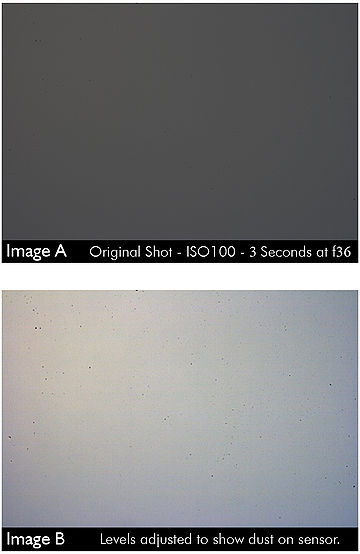
Because the vast majority of image sensors produced exhibit an enclosed design, surface contamination is the only class of defects that may be eliminated through proper cleaning procedures; sensors that contain sub-surface contamination in any form will have to be discarded or sold off for raw material recycling. There are three main sources of surface contamination that we will consider:
- Host device internal mechanisms: The mechanisms of a host device which are near or come into contact with the image sensor may inadvertently deposit contamination onto the sensor while it is in operation.[31]
- Example - The shutter mechanism of most digital camera systems is lubricated and this lubrication may spray onto the image sensor during opening and/or closing of the shutter action.[31]#Standard operational conditions: Image sensors may be employed in various applications were they, through common operations, build up surface contamination due to non-mechanism based factors.[31]#*Example - Camera systems that allow for the interchangeability of lenses will at one point or another expose the camera interior to the atmosphere, allowing for dust and other particulate matter to come into contact with the image sensor.[31]#Reclamation technique utilized: While attempts are made to limit the debris and byproducts produced during the process of extracting image sensors from there host devices/circuit boards, contamination of the sensor surface will invariably be caused in some fraction of cases.
- Example - Improper handling of image sensors by extraction personnel may leave oil residue from fingers or splatter from desoldering equipment on the sensor surface.
It is important that the cleaning method used be effective enough to eliminate any contamination from either of these three sources. Some contaminants, such as stray solder from the extraction process, may however be untreatable and leave the image sensor permanently damaged. The extraction process will not take place in clean room conditions, therefore it is expected that all sensors will exhibit particulate contamination to one degree or another (even with sensors whose host device was sealed from atmosphere; cellphones, etc.).
It is very difficult to anticipate the specific concentrations of contaminants that will originate from each source outlined above. This information is not as critical as determining the specific concentration of contaminates that will render an image sensor inoperable. Statistics concerning camera failure are widely available from consumer review organizations. We can assume that the percentage of extracted image sensors that have too many contaminants will be approximately the same as the overall percentage of cameras that malfunction. It would often be the case that this approximation would tend to be on the low side (as most recycled cameras will be damaged units) but we will take into account that not all damaged host units will have their system failure attributed to image sensor contamination. Useful statistics gathered from the sources outlined above are included for reference below. Based on findings we will assume that 16% of image sensors that are extracted will exhibit fatal contamination.
- On average 10.7% of digital cameras will fail within two years of operation.[32]
- Of the failures studied above, 6.6% can be attributed to digital camera malfunction, while 4.1% were caused by accidents.[32]
- There is a direct correlation between initial camera cost and failure rate, more expensive cameras have lower failure rates and vice versa.[32]
- The typical operational life span of a digital camera is three years (from a study of 60,000 digital cameras purchased in 2006)[32]
- It is projected that cameras in operation for three years will exhibit 15.6% total failure rates.[32]
Industrial Image Sensor Cleaning Process[edit | edit source]
After a suitable amount of reclaimed sensors have been extracted from their host devices and properly categorized/sorted, it is vitally important to future recycling processes that they are thoroughly cleaned. This is especially true for sensitive later stage quality assurance testing and successful marketing to potential clients. In order to maintain recycling efficiency, the cleaning process utilized should be partially if not fully automated and able to process hundreds of sensors simultaneously. It is fortunate that practically all image sensors having been produced contain a low pass filter mounted to the front of the sensor in order to protect it from debris.[31] The natural sealed design of image sensors, along with their application within enclosed host devices, mitigates the need for complicated and costly cleaning methods.[31] Particulate matter and oil-based residues are predicted to be almost 100% of the recoverable surface contaminants that will be encountered.[33] The cleaning method proposed here involves a two stage process that hopes to fulfill the economic criteria outlined above while at the same time ensuring that the reclaimed image sensors are sufficiently cleaned.
The first step is to submerge a large number of image sensors simultaneously into an isopropyl alcohol bath. Once placed into the bath, ultrasonic vibrations will bombard the sensors, knocking loose particulate debris and dust. Isopropyl alcohol exhibits a high miscibility with water, allowing for potential recovery of damaged image sensors due to water contamination. Next the sensors will be placed within a methanol bath. Methanol (the most popular solvent used currently for cleaning during CMOS/CCD fabrication) is to be used during this step because it will not damage the sensor or electronic components and has high miscibility with isopropyl alcohol.[33] The solvent also is exceptional at eliminating oil-based lubricants from the sensor surface; these most commonly originate from the interior mechanical components of the host device.[34] After the methanol bath, the image sensors are immersed in pentane, a compound with extremely high vapor pressure. This whole process allows for the maximum cleaning efficiency while transferring to one miscible solvent to the other. This system also mitigates stiction that occurs between dust particles and the image sensor surface. It is worth noting here that it will be critical to recycle and purify all of the bath solvents after several series of image sensors have been washed. This is to maintain suitable cleaning efficiency and to prevent the buildup of precipitates that may accumulate over the course of several cleaning cycles. An avenue of future research should be to look into the use of super critical C02 liquid as a replacement for the pentane bath (temperature and pressure required for such a step may exceed the tolerance thresholds for most image sensors).
After sufficient time has passed the image sensors are removed from the pentane bath and, by automatic means, are transported into a heating chamber. Here temperature levels are set at approximately 40°C in order to quickly evaporate the remaining methanol so that no residue is left on the sensor surface. This temperature is well below the maximum sustainable temperature for practically all image sensors.[35] During heating, a compressed nitrogen gas will circulate throughout the chamber. This is to facilitate even pentane evaporation as well as blow off any remaining surface particulates that have not been removed. Standard compressed air canisters are unsuitable for this work because of their expulsion of liquid propellants which would recontaminate the sensor surface.[33] Certain particulates may be strongly adhered to the surface of a given image sensor due to static charges.[31] To combat this phenomenon, a static deionizer will be utilized during this phase and combined with the introduction of compressed nitrogen gas.[36] These devices are widely available for manufacturing applications and the Full-Flow Air Knife produced by EXAIR would work well if implemented in this cleaning method.[36]After the image sensor have passed this stage it is critical that they remain in a clean room environment until they are repackaged for sale. This is to prevent any possible recontamination of the sensor surface which would interfere with quality assurance testing and would result in dissatisfied clientele.

Image Sensor Quality Assurance Testing[edit | edit source]

Successful testing of each individual image sensor to be resold accomplishes three main goals; it ensures that a given sensor is free of surface contamination, has not developed abnormalities during it prior use, and still meets or exceeds specifications set by its original manufacturer. In order to market image sensors to clients wishing to implement them in new host devices, it is vitally important that all image sensors pass these three general criterion. If a given image sensor does not pass these requirements it will be deemed defective beyond repair and it will be scrapped or sold for raw material reclamation. To maintain sufficient production efficiency it will be critical for the testing method to be able to either simultaneously test multiple image sensors or process individual sensors at a very fast rate.[37] This phase of repurposing will of course follow the decontamination procedure; therefore it is critical that testing (and all subsequent processing phases) be conducted within a clean room environment.[37]The main technical issue to be overcome by the chosen testing method will be the implementation of a system which is highly adaptable, allowing for different types of image sensors to be analyzed without changing major testing procedures.[37]For simultaneous testing of a given batch of image sensors, it is necessary that they all be exactly similar designs. Therefore image sensors must be sorted prior to quality assurance testing. This is due to the functionality of current image sensor testing equipment available on the market and the practicalities of image sensor design. To elaborate, a given sensor requires several crucial components to facilitate testing. These include a low-noise power source, frame grabber, image processor (for CCD sensors because of their voltage output), controlled illumination source, standardized testing target, dark room, universal socket mount, lens, and control computer with appropriate analysis software.[38] Each type of image sensor must be separately tested because they require specific power levels, focal plane alignment, testing criteria that must be met for their given application and have different pin layouts.[37]Fortunately specification sheets for each image sensor, which outline sensor design details and minimum performance criteria, are widely available and distributed on the internet by major manufacturers. This information will be compiled into an electronic reference database that will be interfaced with by automated testing equipment.[37]The procedure currently utilized by manufacturers to test the image quality of a sensor is on the surface relatively straight forward. The sensor must be held in place by a socket mount, supplied with power, and interfaced with a controller board capable of recording images off of the sensor.[38]Up to four different low-noise power supplies with varying currents may be required for a given sensor. Both the power supplies and PCB image grabber must be interfaced with the sensor via a very specific pin configuration specific to its given design. The sensor is then coupled with a lens and placed within a tightly controlled illumination environment with a standard reference card.[38]Images are recorded from the sensor and processed by computer software in order to determine if the image quality and various other parameters meet specified performance criteria.[37]These parameters include those listed in the overview section of this report as well as others such as number of dead or stuck pixels, color accuracy, modulation transfer function, and dust particle detection.[39] Modern image sensor testing equipment allows for the parallel processing of many individual sensors. Several solutions provided by major testing equipment suppliers are listed below.
| Jova Solutions ISL-4800 Image Sensor Tester |
| Advantest T2000 LSMF+EXMFIS |
| Nextest Magnum iCP Series |
| Teradyne IP750 Ex Image Sensor Device Tester |
| Required Testing Component | Average Cost |
|---|---|
| Power Supply | $900 |
| Digital Frame Capture Card | $2,500 |
| Digital IO PCI Card | $195 |
| Cable Connector Block | $195 |
| I2C/SPI Interface | $300 |
| Timer/Counter Instrument | $2,000 |
| Wiring and Integration | $1,200 |
| Basic Software for Capture and Display | $2,400 |
| Custom Board (Fab. PC Board) NRE | $2,000 (first time approx. $250 after) |
| Advance Analysis Software | $12,000 |
| Total | $26,140 |
The cost of these systems is substantial however; most exceed several hundred thousand dollars.[37]It is possible to assemble the necessary components obtained separately into a working testing system. The following components required specifically for CMOS image sensor testing are included in the following table along with their respective average market price.[37]While it may be tempting to pursue this method of testing due to its attractive cost, there are serious ramifications to its implementation, hidden challenges, and processing shortfalls which make the purchase of an industrial image tester provided by one of the above manufacturers a requirement.[37]Unlike industrial testers, a custom unit will need an interface board specific to the exact image sensor that is to be tested.[37]These are not normally available commercially and must be procured from the original sensor manufacturer.[37]Because of the diverse array of sensors that we hope to recycle, this cost alone would financially equate both testing methods. Industrial testers also have the ability to "hot swap," or in other words remove the image sensor from the testing device without disconnecting power supplies.[37]This allows for fast mounting and remounting of image sensors and drastically improves overall production throughput. Most inexpensive testing units also are unable to be directly connected to image sensors due to the low voltage and current thresholds of the sensor. Expenses increase in order to modulate the signal to a level suitable to be handled by the sensor, but this can be difficult and the monitoring device must be placed extremely close to the sensor if wires are used.[37]These and other differences clearly favor the use of industrial testing solutions, especially from either Jova Solutions or Teradyne, in order to maximize speed, adaptability, and ease of use.
Quantity of Usable Image Sensor After Quality Assurance Testing[edit | edit source]
Quantify the number of usable image sensors that will be yielded after the extraction and cleaning are typically based on real quality produced by a refurbishing line.[40] To project the quantities that will be usable, some assumptions must made.
Assuming that there is a 15-20% failure rate of consumer collected devices will not be functional or suitable for refurbishing.[41]The number of fulling functional units that will be marketable after the inspection of the parts will be 15-20% of the malfunctioning units two generation market that we described above.As the failure rate for a 3 year time span (one generation) is assumed a 15.7%,[20] which represent the number of units that will we expect to recycle. Compounding these values gives a rough expected yield range.
Calculations
Number of nonfunctional units: 0.15*(2*0.157*750,562,472) = 35351492 units and 0.20*(2*0.157*750562472) = 47135323 units; So a 35,351,492 - 47,135,323 image sensors are projected to be nonfunctional.
Potential collection efficiencies: (((2*(0.157)*750562472)-47135323)/(2*(0.157)*750562472)*100) = 80% to (((2*(0.157)*750562472)-35351492)/(2*(0.157)*750562472)*100) = 85% refurbishing efficiency; So a 80 - 85% of image sensors refurbished are projected to be usable.
Energy Consumption[edit | edit source]
Embodied Energy of New Image Sensors[edit | edit source]
The embodied energy of a new image sensor is equal to the summation of the energy of its components. Since image sensors are relatively small and in order to simplify calculations, only the energy involved in producing the silicon wafer and of the micro-lens array were considered in these calculations.[42] In addition, the varying sizes of image sensors available made it necessary to use an average. For this value, the most common size of image sensors (48 X 36 mm) in the average digital camera was used.[43] Below, is a list of further assumptions made in the calculations.
|
Assumptions
|
Calculations Volume of Si and Micro-lenses = 48*36*0.279=482mm3 = 0.000000482m3 Mass of Si =2330*0.000000482=0.00112kg Mass of Micro-lenses=7200*0.000000482=0.00347kg Embodied Energy of the Image Sensor = (4135*0.00112) + (23*0.00347) = 4.711MJ |
Energy Requirements for Recycling[edit | edit source]
The proposed industrial reclamation of image sensors requires collection and shipment of the image sensor containing devices such as cameras and camcorders. However, this is only a model and the distances and modes of transporting the devices can only be estimated. Therefore, a distance of 50 miles was used as an average shipping distance. The mode of transportation considered is in shipping trucks similar to that of the United States Postal Service (UPS). Below again is a list of assumptions made in these calculations.
|
Assumptions |
Calculations Energy used per 50 miles = 1231.25MJ Energy of shipping devices = 1.231MJ Energy of Recycling an Image sensor = [(0.00112+0.00347)*23]+1.231 = 1.337MJ |
The above calculations show that image sensor recycling uses approximately 3.4MJ less than producing a new image sensor.
Down-cycling Compared to Raw Material Recycling[edit | edit source]
Image sensors are a crucial part of many devices. As such, it seems viable that a process which can recover image sensors out of products that are no longer used and sell them at lower price than original manufacturing would be a desirable service. As stated previously, the market for image sensors is only expected to grow. With the increasing cost of virtually everything, a collection and reprocessing of already made devices will become a critical segment of not only the economy by the environment as well.
There are many advantages to the resale and reprocessing of image sensors versus the recycling of image sensor components. For instance, since there is only a small amount of silicon in the image sensor itself, it would be more expensive to extract and clean the silicon than to dispose of the image sensor. Any rare earth metals in the sensors are minimal and again, this would be a highly inefficient way to recycle or reclaim anything from the image sensors. In addition, the image sensor is only a small component of devices like cameras and camcorders. Therefore, the rest of the device would be wasted and if a company only recycled the components of the sensors. With image sensor refurbishing, the image sensor gets reused and the rest of the device gets shipped to another recycling plant which helps to eliminate landfill costs. Furthermore, reclamation of the image sensor components would be a very detailed and time consuming process since this step cannot reasonably be automated.
Proposed Image Sensor Reclamation Facility[edit | edit source]
Up until now much has been discussed concerning several reclamation processes including image sensor collection, extraction, cleaning, and testing. In order to successfully operate a recycling plant, several other processes are crucial and the methods of their interaction must be constructed. On the surface a successful reclamation plant will have several key inputs, outputs, and requirements. Image sensor host devices, chemical solvents, energy, and manpower are the main inputs. Processing equipment and plant personnel then "refine" the inputs to produce fully operational image sensors along with several byproducts; faulty image sensors and chemical waste being the two main ones.
In order to be as successful as possible in this endeavor, it will be critical to couple all of these production factors to other existing industries so that positive symbiotic relationships may form. For example: most waste chemicals are potent explosives that can be used for energy generation by power companies. Forming a good working relationship with these companies to sell our chemical waste in exchange for lower electrical power rates would be most beneficial. The same could also be done with current established electronic recycling foundations. Rather than depend entirely on our own collection methods, we may wish to partner with these existing companies for access to host devices in exchange for our processed faulty devices which we have no use for. Another beneficial partnership would be to form a good working relationship with our potential clients who do not produce their own image sensor devices. With the means to appropriately clean and test a wide array of sensors, they may offer to supply us with their collected host devices (returned to them from their customers) in order to acquire cheaper rates for purchasing our products.
The success of our endeavors lies in achieving two goals. The business model (and by extension, plant operation) will only survive if we are able to collect and process hundreds of thousands of units every year as well as maintain a highly efficient and adaptable reclamation process. Without fulfilling either of these two constraints it will be impossible to supply our clients with a wide product selection and be able to meet their large production-run demands. Correct plant procedures and capital flow through the facility will play a large part in achieving these goals. The following is a general explanation of these factors in order to provide a more overall view of plant activity for better understanding. The equipment required for each processing phase can already be found in the preceding processing specific sections.

The collection process is the first critical step in reclamation of image sensors. A wide spectrum approach will be best in order to obtain the largest amount of host devices possible. Once the host devices are obtained, if they are collected off-site, they will need to be transported to the reclamation facility. This is because extraction must take place in-house to avoid the added difficulty of transporting prospective image sensors without being damaged or adding excessive packaging expenses. The host device of each sensor is in and itself a very well designed packaging device and we will take advantage of this. The extraction process at the best of times will only require the physical detachment of the sensor from its host device, at the worst of times it will require desoldering by skilled personnel or automated rework machines. The most difficult task in extraction will not however be the removal of the image sensor from its ICB but instead the disassembly host devices. Therefore a two stage process will be used to combat both issues. Less skilled personnel will manage device disassembly while skilled personnel coupled with rework devices will be responsible for sensor extraction. Because of the wide array of products that will be processed in this stage, it will be difficult to implement an automated system in every situation to achieve these two requirements. The extraction system will produce a large amount of material waste in the form of spend host devices. These devices will include product housing, lenses, and integrated circuit boards. We will not investigate the recycling of these materials and instead sell them off for raw material reclamation. Some hazardous compounds from the desoldering process will need disposed of in the correct manner. The extraction process is also includes the first quality control check. Personnel will be trained to identify image sensors that are beyond either repair or decontamination; these include physical abnormalities or defects such as scratches or chips in the sensor itself. Sorting and categorizing extracted image sensors will follow the removal process. Because the subsequent production phases require the simultaneous processing of similar image sensors, low-volume sensors may need to be stored until a sufficient amount can be obtained in order to make there processing cost effective.
The cleaning and quality control testing phase of plant operation have already been discussed in detail but it is worth noting several unmentioned factors. Cleaned image sensors that fail to initially pass testing specifications will not be discarded immediately. Instead they will be analyzed by plant personnel visually to determine if there is a resolvable problem such as surface contamination. If no physical defects are visible, the sensor will be sent back through the cleaning process (if it fails subsequent testing a second time it will then be discarded). If the sensor depicts large amounts of surface contamination, it will be processed through by a cleaning method yet to be elaborated upon. Rather than by automated means, this technique will involve physical cleaning of the sensor by personnel trained to eliminate difficult to remove surface contamination with a wide array of tools. If the cleaned sensors are then tested and again fail to pass specifications they will be discarded.
After testing, the sensors must be packaged and stored to await shipment. Packaging, like previous phases, must take place in a clean room environment. The packaging must also be designed in such a way as to not come into contact with image sensors surface. This will of course again require an adaptive system capable of handling a wide array of sensor designs. Packaging runs will most likely alternate quite regularly and a full staff of packaging engineers will need to be employed in order to remain as efficient as possible. Like most other sensor manufacturers, our packaging will mainly consist of plastic shell enclosing the sensor and contacting at points other than the sensor surface. Marketing of the sensors will be just as an important step as any in this business. Our sensors must come in at a lower price point than those newly manufactured and must exceed all performance specifications. We expect that in the coming years that our largest clients will be automotive companies that are currently just starting to widely implement image sensors into their production models. To meet this demand and others simultaneously, the scale of our operation must be massive.
Plant Safety and Hazardous Materials MSDS[edit | edit source]
For the proposed plant design there are two main processes that pose the vast majority of safety hazards to plant personnel: the extraction of image sensors and the subsequent decontamination. There will be of course be general safety measures put into place for other processes as well but these will be very similar to those imposed at any production facility. Examples of these include, general personnel safety training for operating equipment such as forklifts and production lines, proper electrical and mechanical system lockout-tagout procedures, appropriate attire for workers in each facility, and a multitude of other no less important precautions. Processing steps such as quality assurance testing, sorting, repackaging and storage of image sensors pale in comparison to the hazards that will be faced in the extraction and decontamination processes. These hazards will be elaborated upon in the following sections.
Image Sensor Extraction from Host Devices (Solder Rework Hazards)[edit | edit source]
- Proper attire for disassembly workers would long lab coat, antistatic gloves (previously mentioned), and spatter proof eye wear.
- General workplace safety training will be required insure that each worker will be protected from the heavy equipment used to transport the work pieces and protect themselves during accidents
As with most soldering material the greatest health threat is when the product is inhaled (see MSDS for details). Any worker manually desoldering or working near a Electronic Reworking Machine Should be equipped with:
- All equipment necessary to comply with OSHA regulation 1910.134[51]
Material Hazards
- Dry Film Soldermask 3,0 mil MSDS: May cause pain and irritation. Skin contact, eye contact, inhalation and ingestion should be avoided.
- Demanufacturing personnel must where respirators, chemical grade goggles and gloves when desoldering PCBs to protect from injury.
- Sn-Pb MSDS: May cause pain and irritation. Skin contact, eye contact, inhalation and ingestion should be avoided.Danger of cumulative effects.Harmful to the environment if not properly contained.
- All desoldering should should occur under a fume hood and any personnel must wear proper demanufacturing saftey equipment.
- Sn-Cu MSDS: Excessive inhalation of fumes from many metals can produce an acute reaction known as "metal fume fever". Symptoms consist of chills and fever, very similar to and easily confused with flu symptoms. Chronic exposure can cause pneumoconiosis without symptoms of interference with pulmonary function.
- All desoldering should should occur under a fume hood and any personnel must wear proper demanufacturing saftey equipment.
- Sn-Ag-Bi MSDS: Contains material which causes damage to the following organs: lungs, mucous membranes, upper respiratory tract, skin, eye, lens or cornea, nose/sinuses.
- All desoldering should should occur under a fume hood and any personnel must wear proper demanufacturing saftey equipment.
- Sn-Ag-Cu MSDS: Smoke may be irritaitng to the eyes and lungs.
- All desoldering should should occur under a fume hood and any personnel must wear proper demanufacturing saftey equipment.
- Sn-Ag MSDS: Smoke may be irritaitng to the eyes and lungs. Inhalation of CuO of ZnO may cause metal fume fever.
- All desoldering should should occur under a fume hood and any personnel must wear proper demanufacturing saftey equipment.
Sensor Cleaning and Contamination Removal Hazards[edit | edit source]
 |
 |
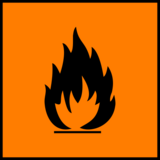 |
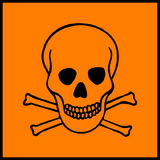 |
The hazards encountered during the image sensor cleaning process originate from the use of dangerous solvents and gases. These chemicals must at all times be properly handled by qualified plant personnel. The following details include the material safety data sheets for each of the chemicals used during the cleaning process as well as an outline of the measures to be taken to ensure plant safety during their prevalent use.
- Isopropyl Alcohol MSDS: Highly toxic. Repeated prolong exposure can cause organ damage. Hazardous if comes into contact with skin, eyes, or is ingested. Highly flammable – explosive. Attacks some plastics and rubber coatings.[52]
- All decontamination personnel are to wear splash goggles, lab coats, and gloves. Facility will include multiple eye and hand wash stations, outdoor accesses for ventilation, and respirators. Chemical will be stored in sealed containers away from ignition sources in a well-ventilated cool area.[52]
- Methanol MSDS: Severe overexposure may result in death. Highly flammable – explosive in vapor form at long distance from ignition source. Extremely toxic. May cause birth defects.[53]
- Personnel are required to wear splash goggle, full suit, gloves, boots and self-contained respirators (when adequate ventilation is not available). Facility will include automatic ventilation system, automatic fire extinguishing system, wash stations, and safety showers. Chemical must be stored in locked, sealed containers away from ignition sources (in approved and segregated area).[53]
- Pentane MSDS: Explosive in presence of either spark or flame. Toxic. Strong eye irritant. Concentrated inhalation exposure can cause central nervous system depression. High concentrations can lead to asphyxiation and often times death.[54]
- Only experienced and authorized personnel should handle chemical. Protective equipment similar to those required for methanol handling should be used. Chemical must be stored in seal containers away from both flame and spark ignition sources. Adequate ventilation must be available in area where chemical is in use.[54]
- Nitrogen Gas MSDS: Simple asphyxiate. Contents under pressure. Odorless. Decrease in environmental oxygen levels of 10% lead to sudden unconsciousness. Contact with liquid may cause frostbite.[55]
- Chemical will only be used in ventilated areas. Facility will include oxygen monitoring system. Containers must be protected against damage and stored in cool environment in order to prevent explosion. No special personnel equipment is required.[55]
Image Sensor Reclamation Flow Chart[edit | edit source]
Below is the flow chart for the collection, extraction, sorting, cleaning and testing of the image sensor recycling model. Please note that the main processes are in all capitals followed by the sub-processes. All other device components will be sent to another recycling plant for processing.
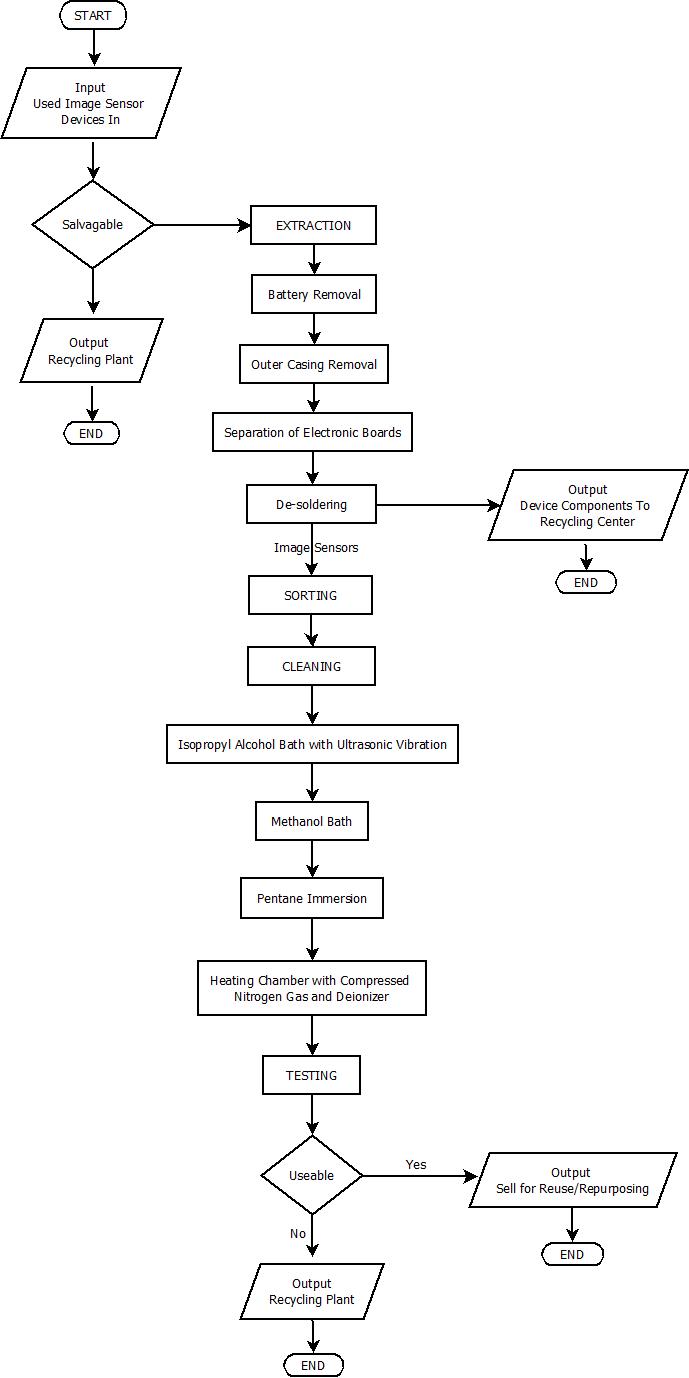
Works Cited[edit | edit source]
- ↑ 1.0 1.1 1.2 1.3 1.4 http://web.archive.org/web/20110529082826/http://www.dalsa.com:80/corp/markets/ccd_vs_cmos.aspx?
- ↑ 2.0 2.1 2.2 2.3 2.4 http://www.cambridgeincolour.com/tutorials/camera-sensors.htm
- ↑ 3.0 3.1 3.2 http://electronics.howstuffworks.com/cameras-photography/digital/question362.htm
- ↑ 4.0 4.1 4.2 4.3 http://www.shortcourses.com/guide/guide2-8.html
- ↑ http://harvestimaging.com/pubdocs/059_2001_apr_VLSI_CCD_or_CMOS.pdf
- ↑ 6.0 6.1 6.2 6.3 6.4 6.5 6.6 6.7 http://www.tmworld.com/electrical-engineers/education-training/tech-papers/4390549/The-Evolution-of-CMOS-Imaging-Technology
- ↑ 7.0 7.1 7.2 7.3 7.4 7.5 http://www.sony.net/SonyInfo/technology/technology/theme/cmos_01
- ↑ 8.0 8.1 http://mydp1.wordpress.com/2007/11/13/whats-the-bif-deal-with-foveon-sensors/
- ↑ http://blog.nikonians.org/digitaldarrell/2011/08/dd-photography-basics-how-does-an-imaging-sensor-work.html
- ↑ http://www.qualitymag.com/articles/90615-sensors-market-analysis-growth-challenges-in-world-image-sensors-market
- ↑ http://www.marketresearchworld.net/index.php?option=com_content&task=view&id=3589&Itemid=2
- ↑ http://www.isuppli.com/Abstract/P13842_20111110150139.pdf
- ↑ 13.0 13.1 http://web.archive.org/web/20120729091858/http://www.pixim.com/news-and-events/pixim-in-the-news/Image-Sensors-on-the-Lookout
- ↑ http://web.archive.org/web/20160522013514/http://www.call2recycle.org:80/how-program-works/
- ↑ 15.0 15.1 15.2 http://eelndom1.ee.doe.gov/OIT/oitpdf.nsf/Files/colorsensor.pdf/$file/colorsensor.pdf
- ↑ http://shmst.en.ec21.com/Plastic_Pellet_Color_Sorter--4227568_4227570.html
- ↑ 17.0 17.1 17.2 http://web.archive.org/web/20131109080936/http://www.cipa.jp:80/english/data/dizital.html
- ↑ http://web.archive.org/web/20110911051031/http://www.cipa.jp:80/english/data/pdf/list.pdf participating companies
- ↑ 19.0 19.1 http://www.bloomberg.com/news/2011-04-15/sony-nikon-narrow-gap-to-canon-with-new-digital-camera-models.html
- ↑ 20.0 20.1 20.2 http://www.squaretrade.com/htm/pdf/Camera_failure_study.pdf
- ↑ S. Chatterjee and Krishna Kumar, "Effective electronic waste management and recycling process involving formal and non-formal sectors" International Journal of Physical Sciences Vol. 4 (13) pp. 893-905, December, 2009 Available HTTP: http://www.academicjournals.org/ijps ISSN 1992 - 1950 2009 Academic Journals]
- ↑ 22.0 22.1 22.2 http://www.electronicstakeback.com/wp-content/uploads/Report_Card_Company_Grades_Combined.pdf
- ↑ http://i.dell.com/sites/content/corporate/corp-comm/en/Documents/dell-fy12-cr-report.pdf
- ↑ 24.0 24.1 24.2 http://www.epa.gov/osw/conserve/materials/ecycling/docs/fullbaselinereport2011.pdf
- ↑ K. Studstill,"Apple Introduces 'Tamper-Resistant' hardware screws DIY Community Reacts",PSFK, available http://www.psfk.com/2011/01/apple-introduces-tamper-resistant-hardware-screws-diy-community-reacts.html
- ↑ http://www.ifixit.com/Tools/Pro-Tech-Toolkit/IF145-072
- ↑ Gabriel Torres. (2005, July 8). How To Desolder Components [Professional Blog]. Available HTTP: http://www.hardwaresecrets.com/article/How-To-Desolder-Components/164/1
- ↑ 28.0 28.1 28.2 I. Stobbe, H. Griese, H. Potter, H. Reichl, and L. Stobbe, "Quality assured disassembly of electronic components for reuse," pp. 299–305
- ↑ 29.0 29.1 Air Vac Engineering, DRS25: Semi Automated SMT Rework & Repair [Corporate Website] Available HTTP: http://web.archive.org/web/20160117104723/http://www.air-vac-eng.com/drs25.html
- ↑ 30.0 30.1 R. Ramesham, R.D. Gerke, "Survey of Rework Methods/Equipment and Contract Manufacturers for Various Packaging Technologies ," NASA JPL, Pasadena, CA, Rep. JPL D-30275, 2004.
- ↑ 31.0 31.1 31.2 31.3 31.4 31.5 31.6 http://www.cleaningdigitalcameras.com/
- ↑ 32.0 32.1 32.2 32.3 32.4 http://www.squaretrade.com/digital-camera-failure-rates-03-2010
- ↑ 33.0 33.1 33.2 http://web.archive.org/web/20180621054217/http://www.bythom.com:80/cleaning.htm
- ↑ http://www.cleaningsensors.com/
- ↑ http://web.archive.org/web/20121031130431/http://www.sony.net:80/Products/SC-HP/pro/image_senser/index.html
- ↑ 36.0 36.1 http://web.archive.org/web/20170619232751/http://www.exair.com/en-US/Primary%20Navigation/Products/Static%20Eliminators/Pages/Selecting%20The%20Right%20Static%20Eliminator.aspx
- ↑ 37.00 37.01 37.02 37.03 37.04 37.05 37.06 37.07 37.08 37.09 37.10 37.11 37.12 37.13 http://www.jovasolutions.com/isl-white-paper/82-isl-3200-white-paper
- ↑ 38.0 38.1 38.2 http://web.archive.org/web/20130821084223/http://www.electroiq.com:80/articles/ap/print/volume-17/issue-2/features/inspection-amp-test-practical-issues-in-image-sensor-module-testing.html
- ↑ http://www.imatest.com/docs/iqfactors/
- ↑ H. Huang, J. Pan, Z. Liu, S. Song, and G. Liu, "Study on Disassembling Approaches of Electronic Components Mounted on PCBs," in Advances in Life Cycle Engineering for Sustainable Manufacturing Businesses, S. Takata and Y. Umeda, Eds. London: Springer London, pp. 263–266.
- ↑ http://web.archive.org/web/20150723015923/http://www.eco-cell.com/wp/wp-content/resources/umicor_mppi-geneva-0406.pdf
- ↑ http://www.dummies.com/how-to/content/the-components-of-a-digital-cameras-image-sensor.html
- ↑ http://en.wikipedia.org/wiki/Image_sensor_format
- ↑ http://www.virginiasemi.com/pdf/semi%20specificationsoverview71002.pdf
- ↑ http://en.wikipedia.org/wiki/Microlens
- ↑ 46.0 46.1 http://web.mit.edu/ebm/www/Publications/9_Paper.pdf
- ↑ http://en.wikipedia.org/wiki/Density
- ↑ http://web.archive.org/web/20150907044546/http://istc.illinois.edu/about/SeminarPresentations/20111024.pdf
- ↑ http://hypertextbook.com/facts/2004/ShayeStorm.shtml
- ↑ http://www.c2es.org/technology/factsheet/FreightTransportation
- ↑ [CDCsolder] D. Almaguer, MS G. E. Burroughs, PhD, CIH, CSP A. Echt, MPH, CIH D. Marlow (2008) "CONTROL TECHNOLOGY AND EXPOSURE ASSESSMENT FOR ELECTRONIC RECYCLING OPERATIONS ELKTON FEDERAL CORRECTIONAL INSTITUTION ELKTON, OHIO", U.S. DEPARTMENT OF HEALTH AND HUMAN SERVICES, Avalible http://web.archive.org/web/20170601074523/https://www.cdc.gov/niosh/surveyreports/pdfs/ECTB-326-12a.pdf
- ↑ 52.0 52.1 http://web.archive.org/web/20181206195423/http://www.sciencelab.com:80/msds.php?msdsId=9924412
- ↑ 53.0 53.1 http://web.archive.org/web/20181127001302/http://www.sciencelab.com:80/msds.php?msdsId=9927227
- ↑ 54.0 54.1 http://web.archive.org/web/20181003203139/http://www.sciencelab.com:80/msds.php?msdsId=9927384
- ↑ 55.0 55.1 http://web.archive.org/web/20150513232801/http://www.keengas.com:80/msds_6_569514347.PDF
